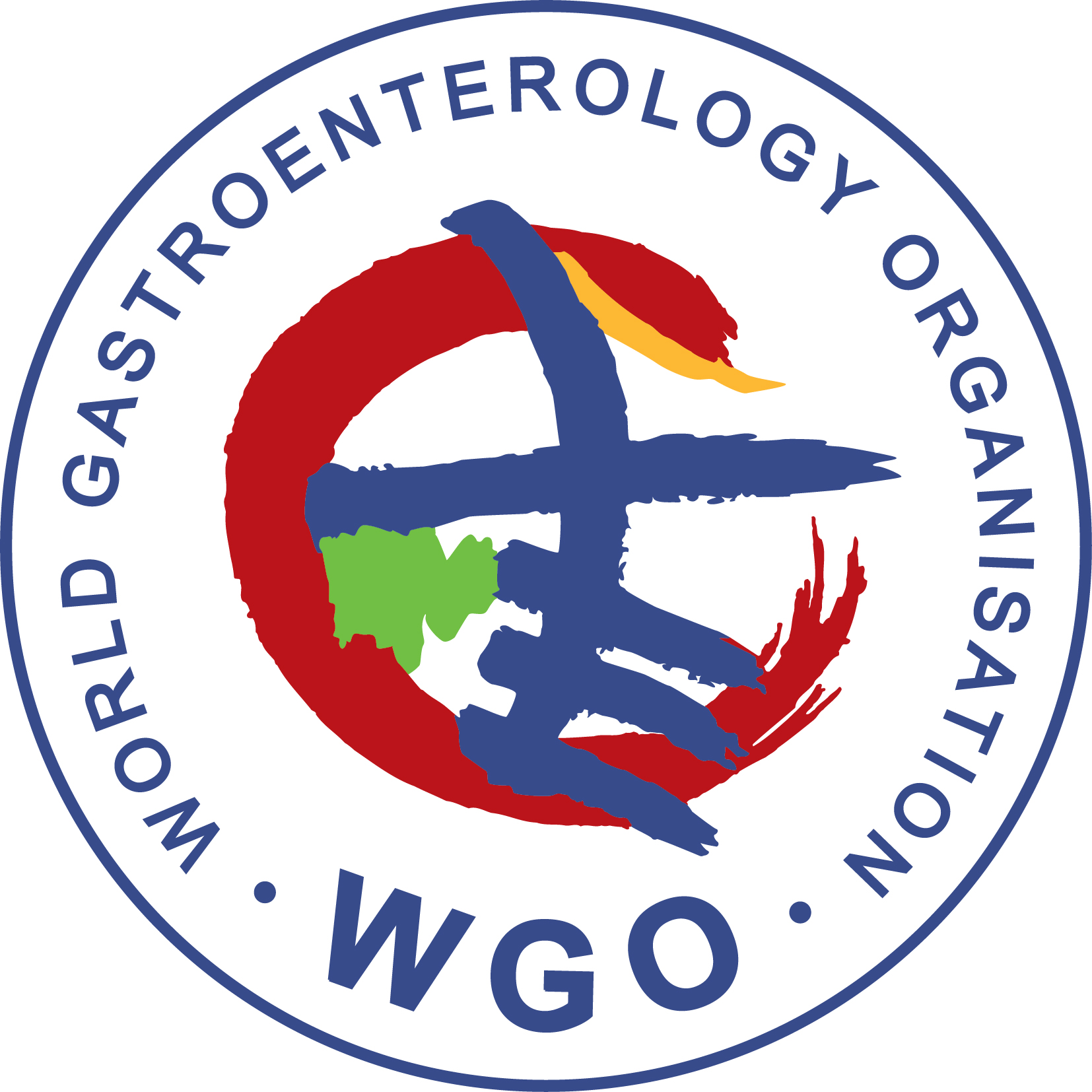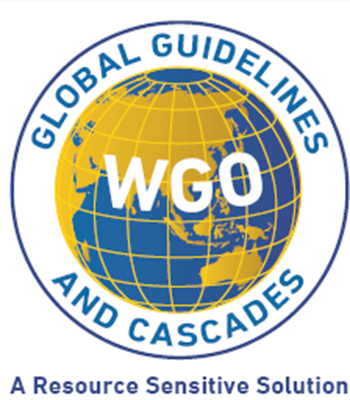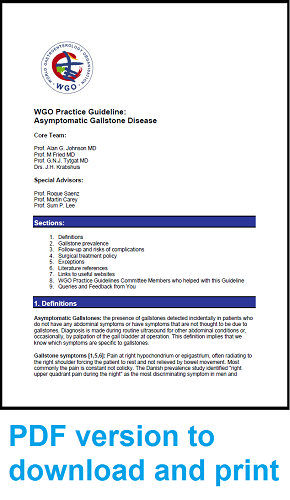Prof. Roque Saenz
Prof. Martin Carey
Prof. Sum P. Lee
1. Definitions
Asymptomatic Gallstones: the presence of gallstones detected incidentally in patients who do not have any abdominal symptoms or have symptoms that are not thought to be due to gallstones. Diagnosis is made during routine ultrasound for other abdominal conditions or, occasionally, by palpation of the gall bladder at operation. This definition implies that we know which symptoms are specific to gallstones.
Gallstone symptoms [1,5,6]: Pain at right hypochondrium or epigastrium, often radiating to the right shoulder forcing the patient to rest and not relieved by bowel movement. Most commonly the pain is constant not colicky. The Danish prevalence study identified "right upper quadrant pain during the night" as the most discriminating symptom in men and "strong and oppressive pain, provoked by fatty meals" as the symptom best correlating with the presence of gallstones in women [7]. Many patients present with vague indigestion and bloating which are more likely to be related to irritable bowel syndrome. However sometimes it is very difficult to decide whether gallstones are or are not causing the symptoms. For example, the location of the pain is often epigastric and this may be misinterpreted as peptic ulcer disease particularly if the pain comes on after meals and at night.
2. Gallstone prevalence
In Europe about 10% of all adults have gallstones, with women having 3 times the prevalence of men during the fertile period [2,9]. Overall the prevalence in women is twice that in men. The prevalence rises with age in both sexes and at the age of 65 about 30% of women have gallstones, and by the age of 80, 60% of both men and women have them.
3. Follow-up and risks of complications
There has been no long-term follow up study from the first gallstone formation to the death of the patient, for obvious reasons. In Denmark, asymptomatic gallstones were detected by ultrasound screening of a population, which was then followed up for 11 years. Complication rates (acute pancreatitis, obstructive jaundice, cholecystitis) are 0.2 - 0.8% per annum. However some of the conclusions of this study have been criticised by Heaton who suggested that cohort selection did not meet all methodological rigour, symptomatic patients were removed from the cohort early for surgery [6].
The Italian (GREPCO) study suggests an annual complication rate of 0.3 - 1.2% if the stones are initially asymptomatic and 0.7 - 2% per annum if the stones are initially symptomatic [9].
The risk of developing gall bladder cancer is 0.3% over 30 years in one study and 0.25% for women and 0.12% for men in another over a similar period. Some studies suggest a much higher cancer risk with stones larger than 3cm size. There are animal studies suggesting other co-cancerous factors exist.
It is very rare to find gall bladder cancer without stones except in the rare condition of adenomatous polyps. It has been shown that cholelithiasis, especially if accompanied by chronic bacterial colonization, goes through the sequency of chronic inflammation - metaplasia - dysplasia - neoplasia. Many studies have followed the morphological changes with gene markers.
Risks of cholecystectomy
The overall mortality risk of cholecystectomy varies from 0.14-0.5% in different series depending on the age and fitness of the patients. There is now evidence that cholecystectomy leads to a slightly increased risk of right sided coloncancer in women after 15 years. There is also an increase in gastrooesophageal bile reflux and of diarrhoea after cholecystectomy (in patients with irritable bowel syndrome and loose stools). In addition to the overall mortality risk of cholecystectomy there is an ongoing and perhaps increasing problem of bile duct injury with its associated long term morbidity. This is another compelling argument against laparoscopic cholecystectomy for asymptomatic gallstones.
4. Surgical treatment policy
When a group of nine surgeons assessed 252 patients who had undergone cholecystectomy, they only agreed that the operation was appropriate in 52% of cases and could not agree in 44%. It is therefore difficult to agree which symptoms are specifically biliary and therefore will be cured by cholecystectomy. However, where there are no symptoms at all, it is clear that cholecystectomy confirms no benefit in patients with asymptomatic gallstones and even in patients with one attack of uncomplicated gallstone pain. The risks of the operation outweigh the complications if the stones are left.
Because of the presumed frequency and dysfunctionality in the apical sodium-dependent bile acid transporter (ASBT) 1-2% of post-cholecystectomy patients have chronic diarrhea and they require bile acid sequestrants for management.
The risk benefit calculations are as follows: Suppose out of 10,000 patients with asymptomatic stones, 200 patients will develop acute complications over 10 years with a death rate of 2,5% (5 patients) and 100 will develop acute pancreatitis with a 10% death rate (10 patients). Thus, 15 patients will die from gallstone complications. If all 10,000 had surgery, between 10 to 50 would die from complication of the surgery. The follow up deaths are spread over 10 years, whereas the operative deaths would occur immediately.
Financial considerations
The cost of prophylactic surgery, given the prevalence of gallstones, would be high. Calculations based on average costs in a British hospital would be almost £ 4 million / 10,000 patients with asymptomatic stones.
5. Exceptions
Exceptions to this policy – of not operating on asymptomatic gallstones – may depend on whether the patient is scheduled for another abdominal operation or whether an operation is carried out specifically for the presence of gallstones.
Exceptions
- Patients who are known to have gallstones and may be living in a part of the world that is very remote from medical treatment, should they get a complication.
- Cholecystectomy in asymptomatic patients with gallstones should be considered in individuals living in high risk areas such as Chile and Bolivia in South America.
- Patients with immune suppression e.g. after transplantation. These may have a far higher risk should they develop a complication such as cholangitis. But also cyclosporin A and tacrolimus (FK 506) are prolithogenic because of decreased bile salt export pump function (BSEP).
- Patients with insulin-dependent diabetes do not have a higher prevalence of stones, but when elderly, have a higher risk should they develop inflammatory complications.
- Patients with rapid weight loss, weight cyclers and those with higher risks of complications generally.
- Patients with calcified 'porcelain' gallbladder as these are also at high risk of evolving into cancer.
6. Literature references
- Abdominal symptoms: Do they predict gallstones? A systematic review Berger-M-Y, Van-der-Velden-J-J-I-M, Lijmer-J-G, De-Kort-H, Pains-A, Bohnen-A-M, Scandinavian Journal of Gastroenterology 2000, 35/1 (70-76) Pubmed-Medline.
- Clinical manifestations of gallstone disease: Evidence from the Multicenter Italian Study on Cholelithiasis (MICOL) Festi-D, Sottili-S, Colecchia-A, Attili-A, Mazzella-G, Roda-E, Romano-F, Lalloni-L, Taroni-F, Barbara-L, Menotti-A, Ricci-G, Hepatology 1999, 30/4 (839-846) Pubmed-Medline.
- Abdominal symptoms and food intolerance related to gallstones Thijs-C, Knipschild-P Journal of Clinical Gastroenterology 1998, 27/3 (223-231) Pubmed-Medline.
- Dyspepsia- how noisy are gallstones ? A meta-analysis of epidemiologic studies of biliary pain, dyspeptic symptoms and food intolerance Kraag-N, Thijs-C, Knipschild-P. Scand J Gastroenterol, 1995:30 (411-421) Pubmed-Medline.
- Which abdominal symptoms are due to stones in the gallbladder Jørgensen T, Kay L, Hougaard Jensen K. Gastroenterology 1994;106:A342
- Symptomatic and silent gall stones in the community Heaton-K-W, Braddon-F-E-M, Mountford-R-A, Hughes-A-O, Emmett-P-M. Gut 1991, 32/3 (316-320) Pubmed-Medline.
- Abdominal symptoms and gallstone disease: An epidemiological investigation, Jorgensen-T. Hepatology 1989, 9/6 (856-860) Pubmed-Medline.
- Correlation between gallstones and abdominal symptoms in a random population. Results from a screening study Glambek-I, Arnesjo-B, Soreide-O. Scandinavian Journal of Gastroenterology 1989, 24/3 (277-281) Pubmed-Medline.
- Prevalence of gallstone disease in an Italian adult female population. Rome Group for the Epidemiology and Prevention of Cholelithiasis (GREPCO), Capocaccia-L, Giunchi-G, Pocchiari-F, et-al. American Journal of Epidemiology 1984, 119/5 (796-805). Pubmed-Medline.
7. Links to useful websites
Society for Surgery of the Alimentary Tract
Treatment of gallstone and gallbladder disease. Inc.. 1998 Jun 3 (revised 2000 Jan). 5 pages.
Society of American Gastrointestinal Endoscopic Surgeons
Guidelines for the clinical application of laparoscopic biliary tract surgery. 1990 (updated 1999). 3 pages.
Optimed Medical Systems Clinical Development Group
Cholecystectomy. 1989 (revised 2000). The software includes over 19 menus and requires user to spend 2-5 minutes depending on the clinical information.
American College of Radiology
ACR Appropriateness Criteria for evaluation of patients with acute right upper quadrant pain. 1996 (revised 1999). 5 pages.
National Guidelines Clearing House
At the NGC site type 'cholelithiasis' in the searchbox for an overview of all guidelines which mention this term.
8. WGO Practice Guidelines Committee Members who helped with this Guideline
Prof. RN Allan
Prof. Franco Bazzoli
Dr. Philip Bornman
Dr Ding-Shinn Chen
Dr. Henry Cohen
Prof. A. Elewaut
Dr. Suliman S. Fedail
Prof. Michael Fried
Prof. Alfred Gangl
Prof. Joseph E. Geenen
Dr. Saeed S. Hamid
Dr. Richard Hunt
Prof. Günter J. Krejs
Prof. Shiu-Kum Lam
Dr. Greger Lindberg
Prof. Juan-R. Malagelada
Prof. Peter Malfertheiner
Prof. Roque Saenz
Dr. Nobuhiro Sato
Prof. Mahesh V. Shah
Dr. Patreek Sharma
Dr. Jose D. Sollano
Prof. Alan B.R. Thomson
Prof. Guido N. J. Tytgat
Dr. Nimish Vakil
Dr. Hou Yu Liu
9. Queries and Feedback from You
INVITATION TO COMMENT
The Practice Guidelines Committee welcomes any comments and queries that readers may have. Do you feel we have neglected some aspects of the topic? Do you think that some procedures are associated with extra risk? Tell us about your own experience. You are welcome to click on the link below and let us know your views.
guidelines@worldgastroenterology.org




